Mapping and Monitoring Spatio-Temporal Patterns of Rainfed Agriculture Lands of North Darfur State, Sudan, Using Earth Observation Data
Abstract
:1. Introduction
2. Materials and Methods
2.1. Study Area
2.2. Remote Sensing Data Acquisition and Pre-Processing
2.3. Reference Data
2.4. Classification of Images
2.5. Change Detection
2.6. Accuracy Assessment
3. Results
3.1. Spatial Distribution of Rainfed Agriculture and Other Land Cover Classes
3.2. Accuracy Assessment
3.3. Spatio-Temporal Trends of the Rainfed Agriculture and Other Land Cover Classes
3.3.1. Trends in Rainfed Agriculture and Other Land Cover Classes from 1984 to 1989
3.3.2. Trends in Rainfed Agriculture and Other Land Cover Classes from 1994 to 1999
3.3.3. Trends in Rainfed Agriculture and Other Land Cover Classes from 2004 to 2009
3.3.4. Trends of Rainfed Agriculture and Other Land Cover Classes from 2014 to 2019
4. Discussion
5. Conclusions
Author Contributions
Funding
Data Availability Statement
Acknowledgments
Conflicts of Interest
Appendix A. Scenes ID Data 1984 Scenes ID Data 1989
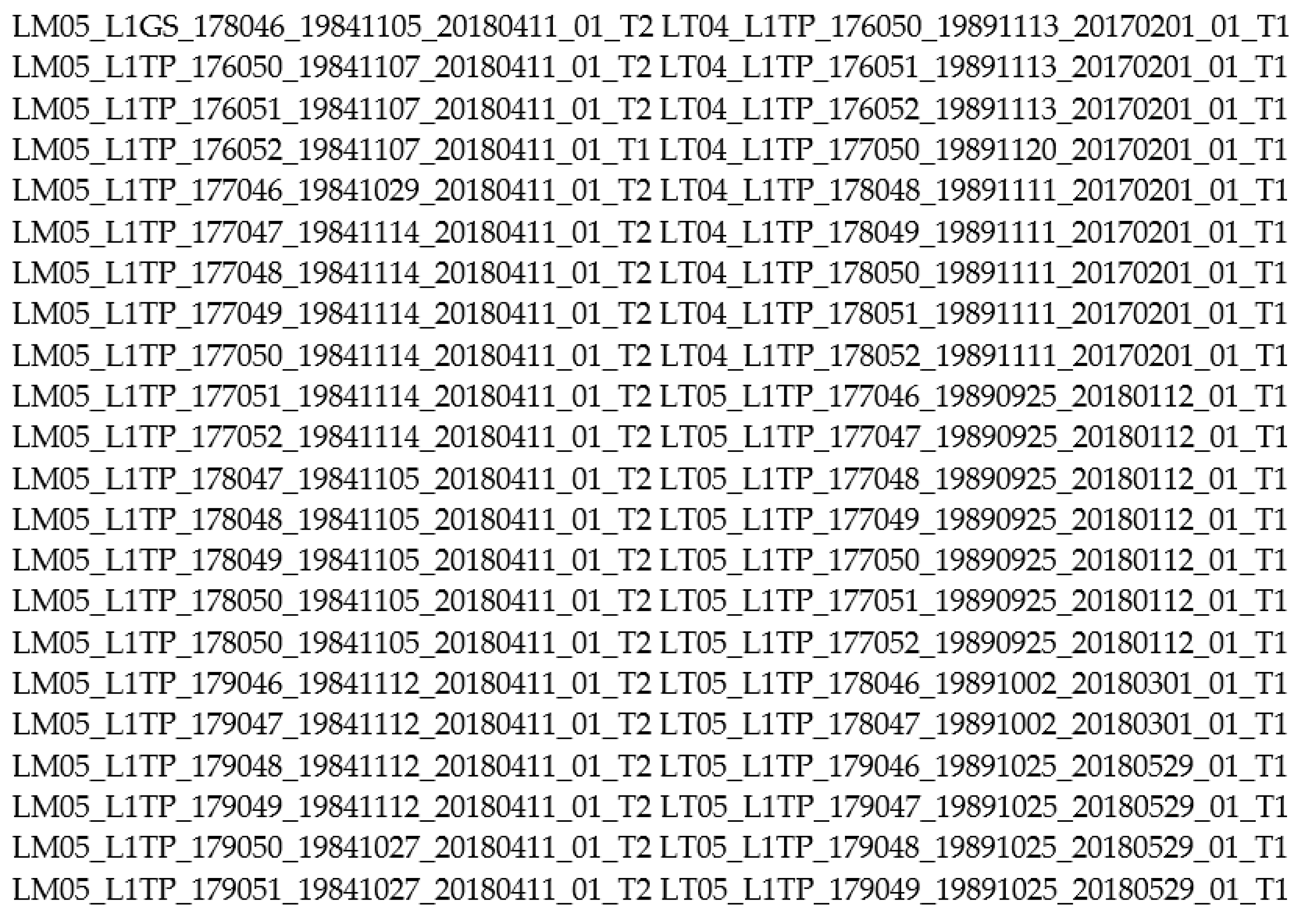
Appendix B. Scenes ID Data 1994 Scenes ID Data 1999
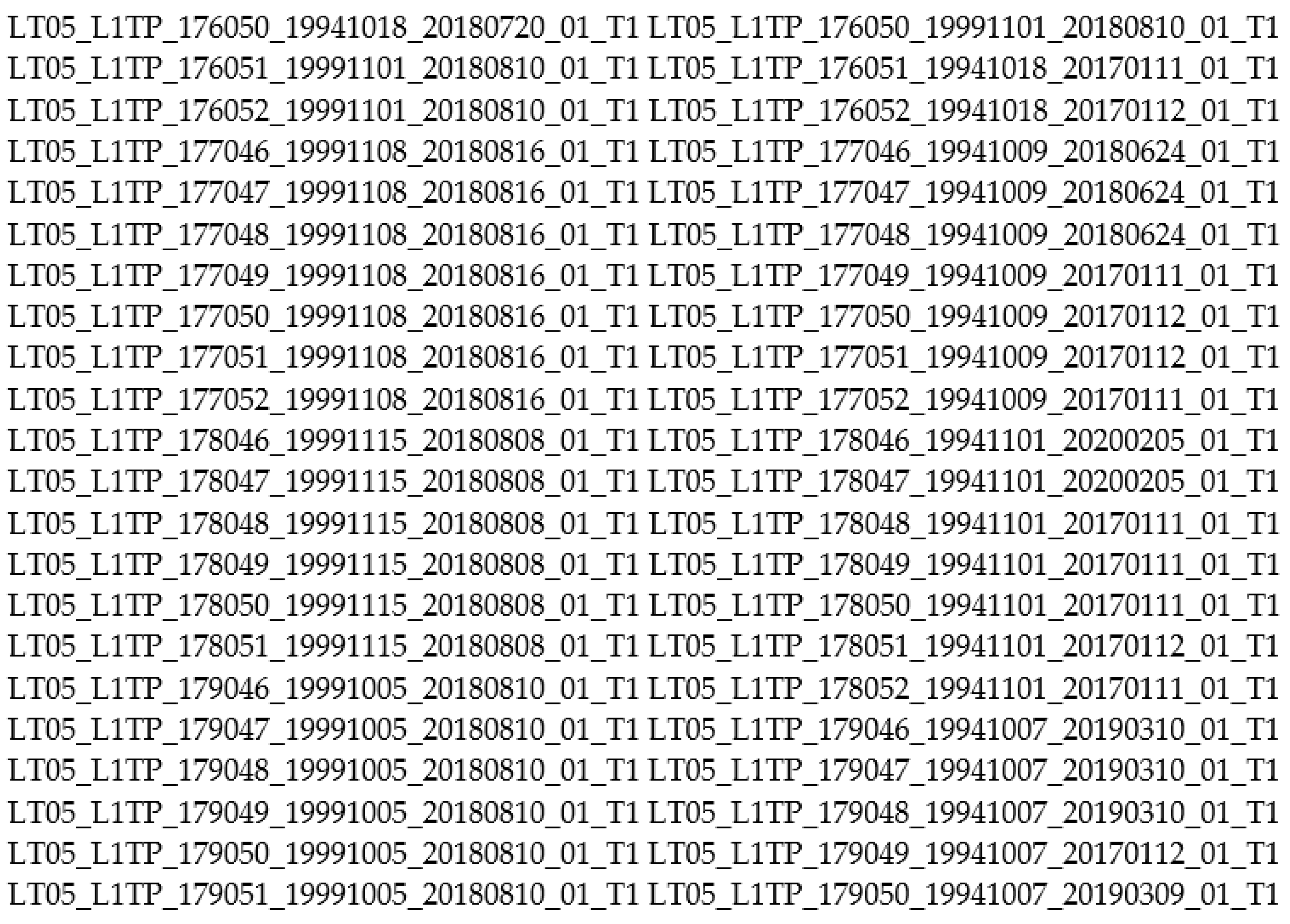
Appendix C. Scenes ID Data 2004 Scenes ID Data 2009
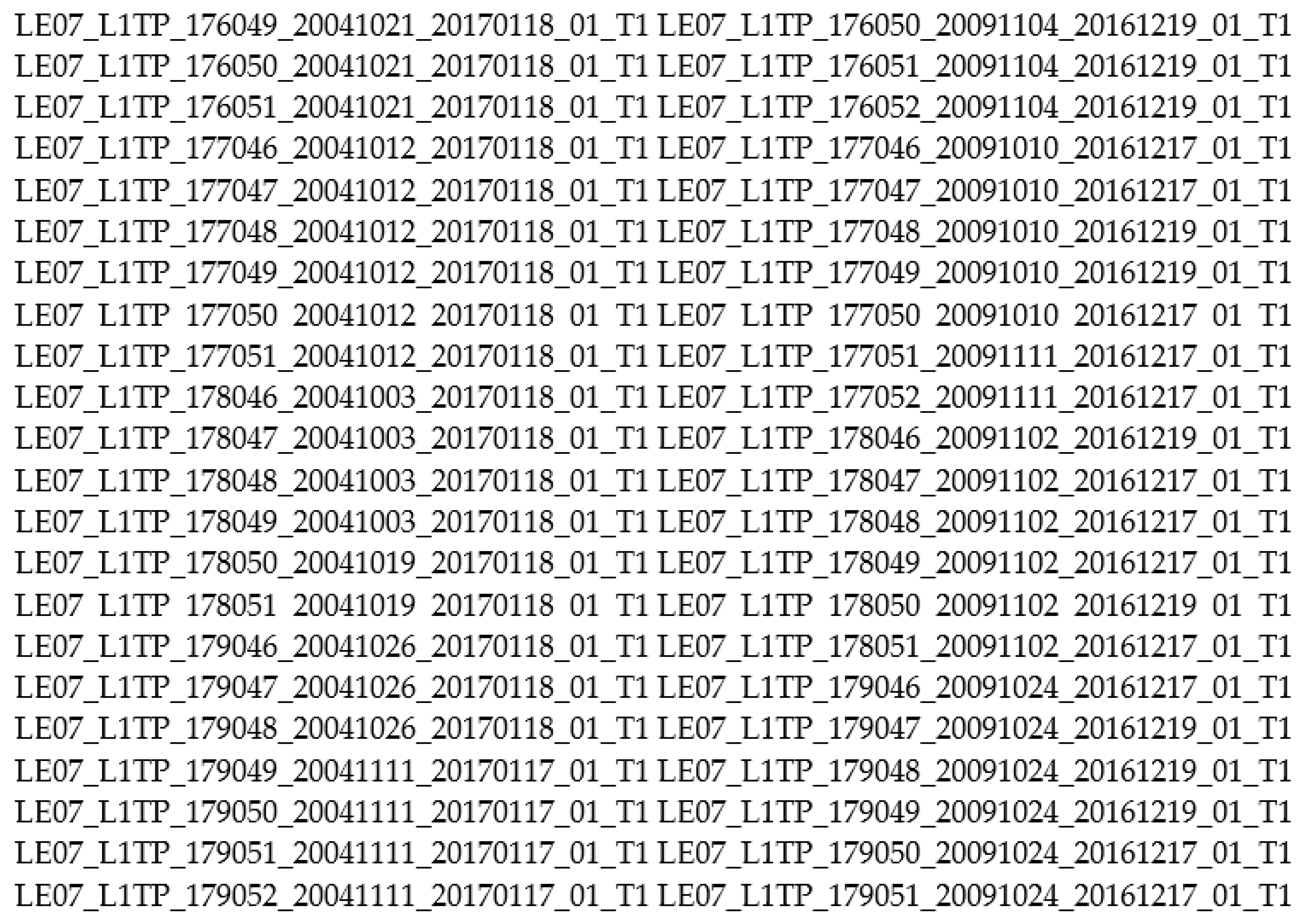
Appendix D. Scenes ID Data 2014 Scenes ID Data 2019
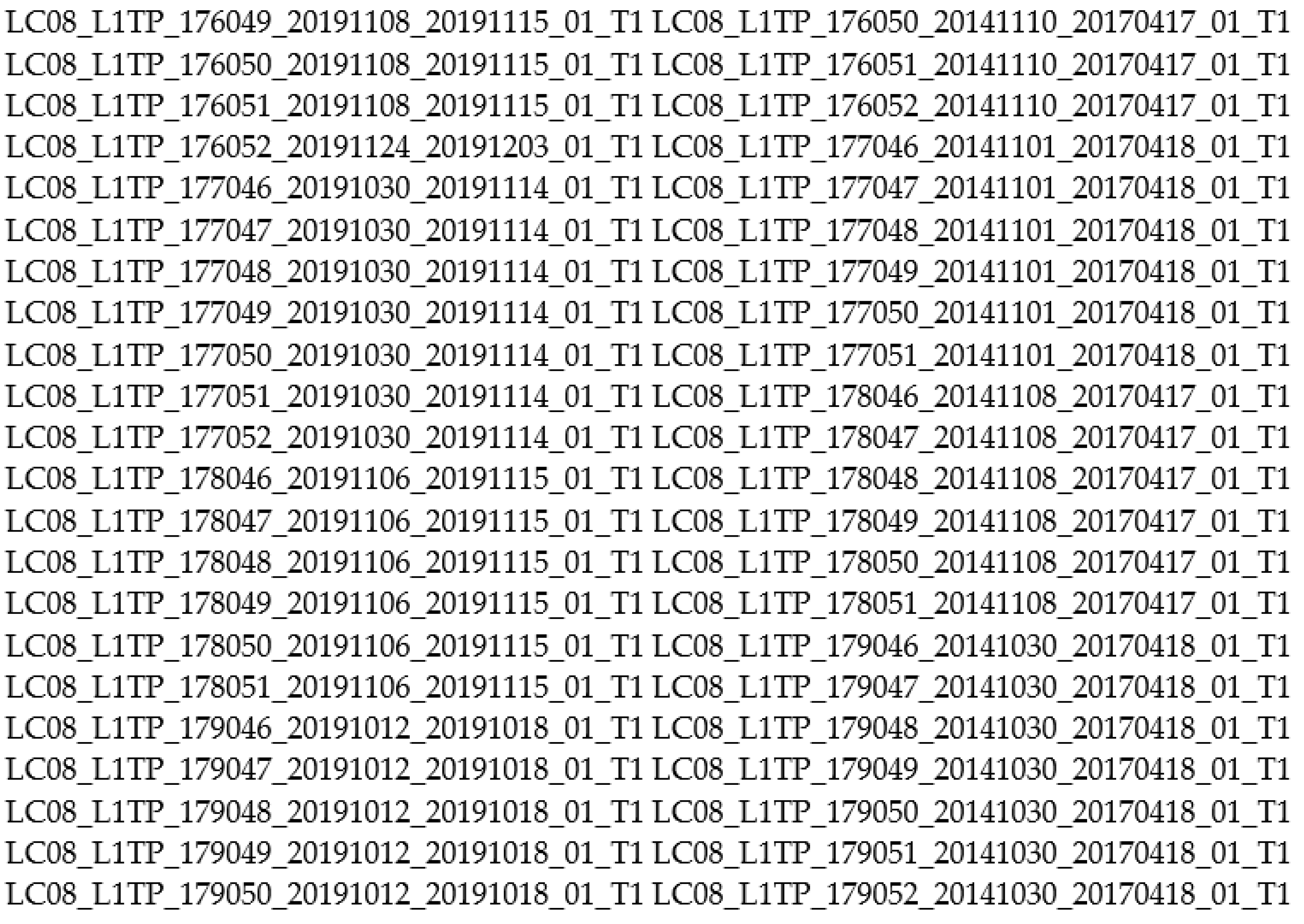
References
- Elagib, N.A.; Khalifa, M.; Rahma, A.E.; Babker, Z.; Gamaledin, S.I. Performance of major mechanized rainfed agricultural production in Sudan: Sorghum vulnerability and resilience to climate since 1970. Agric. For. Meteorol. 2019, 276, 107640. [Google Scholar] [CrossRef]
- Bradford, J.B.; Schlaepfer, D.R.; Lauenroth, W.K.; Yackulic, C.B.; Duniway, M.; Hall, S.; Jia, G.; Jamiyansharav, K.; Munson, S.M.; Wilson, S.D. Future soil moisture and temperature extremes imply expanding suitability for rainfed agriculture in temperate drylands. Sci. Rep. 2017, 7, 12923. [Google Scholar] [CrossRef] [PubMed] [Green Version]
- Laux, P.; Jäckel, G.; Tingem, R.M.; Kunstmann, H. Impact of climate change on agricultural productivity under rainfed conditions in Cameroon—A method to improve attainable crop yields by planting date adaptations. Agric. For. Meteorol. 2010, 150, 1258–1271. [Google Scholar] [CrossRef]
- Sohoulande, C.D.; Stone, K.; Szogi, A.; Bauer, P. An investigation of seasonal precipitation patterns for rainfed agriculture in the Southeastern region of the United States. Agric. Water Manag. 2019, 223, 105728. [Google Scholar] [CrossRef]
- Rockström, J.; Karlberg, L.; Wani, S.P.; Barron, J.; Hatibu, N.; Oweis, T.; Bruggeman, A.; Farahani, J.; Qiang, Z. Managing water in rainfed agriculture—The need for a paradigm shift. Agric. Water Manag. 2010, 97, 543–550. [Google Scholar] [CrossRef] [Green Version]
- Siddig, K.; Stepanyan, D.; Wiebelt, M.; Grethe, H.; Zhu, T. Climate change and agriculture in the Sudan: Impact pathways beyond changes in mean rainfall and temperature. Ecol. Econ. 2020, 169, 106566. [Google Scholar] [CrossRef] [Green Version]
- Siddig, K.; Elagra, S.; Grethe, H.; Mubarak, A. A Post-Separation Social Accounting Matrix for the Sudan; Intl Food Policy Res Inst: Washington, DC, USA, 2018; Volume 8. [Google Scholar]
- Fuller, T.D. Resettlement as a desertification control measure: A case study in Darfur Region, Sudan—Part I: Review of the problem. Agric. Adm. Ext. 1987, 25, 215–234. [Google Scholar] [CrossRef]
- Ibrahim, F.N. Ecological Imbalance in the Republic of the Sudan: With Reference to Desertification in Darfur; Bayreuth Verlagsgesellschaft: Bayreuth, Germany, 1984. [Google Scholar]
- Osman, A.M.K.; Young, H.; Houser, R.F.; Coates, J.C. Agricultural change, land, and violence in protracted political crisis. In An Examination of Darfur. Oxfam America Research Backgrounder Series; Oxfam America: Boston, MA, USA, 2013. [Google Scholar]
- Osman, A.K. Community based seed supply in Sudan. Leisa-Leusden 2007, 23, 18. [Google Scholar]
- Abdelaziz, H.H.; Abdalla, A.A.; AbdelLatif, M.A. Optimizing the Cropping Pattern in North Darfur State, Sudan: A Study of Dar Elslam District. J. Appl. Sci. Res. 2010, 6, 156–164. [Google Scholar]
- Ali, E.-A.D.M.; Mohamedain, M.S. Assessment of Desertification at Umm Bayada Basin (Al Maleha Locality North Darfur State-Sudan). Int. J. Curr. Microbiol. App. Sci. 2016, 5, 94–108. [Google Scholar] [CrossRef] [Green Version]
- Osman, A. Agricultural Change, Land and Violence: An Examination of the Region of Darfur, Sudan. Ph.D. Dissertation, Tufts University, Boston MA, USA, 2012. [Google Scholar]
- Brauch, H.G. Desertification–a new security challenge for the Mediterranean? Policy agenda for recognising and coping with fatal outcomes of global environmental change and potentially violent societal consequences. In Desertification in the Mediterranean Region. A Security Issue; Springer: Berlin/Heidelberg, Germany, 2006; pp. 11–85. [Google Scholar]
- Ibrahim, F. Anthropogenic causes of desertification in Western Sudan. GeoJournal 1978, 2, 243–254. [Google Scholar] [CrossRef]
- Mohammed, A.J.; Inoue, M. Forest-dependent communities’ livelihood in decentralized forest governance policy epoch: Case study from West Shoa zone, Ethiopia. J. Nat. Resour. Policy Res. 2013, 5, 49–66. [Google Scholar] [CrossRef]
- Mohmmed, A.; Zhang, K.; Kabenge, M.; Keesstra, S.; Cerdà, A.; Reuben, M.; Elbashier, M.M.; Dalson, T.; Ali, A.A. Analysis of drought and vulnerability in the North Darfur region of Sudan. Land Degrad. Dev. 2018, 29, 4424–4438. [Google Scholar] [CrossRef]
- Osman, A.M.K.; Cohen, M.J. We No Longer Share the Land: Agricultural Change, Land, and Violence in Darfur; Oxfam International: Oxford, UK, 2014. [Google Scholar]
- Young, H.; Osman, A.M.; Aklilu, Y.; Dale, R.; Badri, B.; Fuddle, A. Darfur 2005 Livelihoods Under Siege; Feinstien International Famine Center, Tufts University: Medford, OR, USA, 2005; Volume 130. [Google Scholar]
- De Marinis, P.; De Petris, S.; Sarvia, F.; Manfron, G.; Momo, E.J.; Orusa, T.; Corvino, G.; Sali, G.; Borgogno, E.M. Supporting Pro-Poor Reforms of Agricultural Systems in Eastern DRC (Africa) with Remotely Sensed Data: A Possible Contribution of Spatial Entropy to Interpret Land Management Practices. Land 2021, 10, 1368. [Google Scholar] [CrossRef]
- Thyagharajan, K.; Vignesh, T. Soft computing techniques for land use and land cover monitoring with multispectral remote sensing images: A review. Arch. Comput. Methods Eng. 2019, 26, 275–301. [Google Scholar] [CrossRef]
- Elagib, N.A.; Al Zayed, I.S.; Saad, S.A.G.; Mahmood, M.I.; Basheer, M.; Fink, A.H. Debilitating floods in the Sahel are becoming frequent. J. Hydrol. 2021, 599, 126362. [Google Scholar] [CrossRef]
- Sahajpal, R.; Fontana, L.; Lafluf, P.; Leale, G.; Puricelli, E.; O’Neill, D.; Hosseini, M.; Varela, M.; Reshef, I. Using machine-learning models for field-scale crop yield and condition modeling in Argentina. In Proceedings of the XII Congreso de AgroInformática (CAI 2020)-JAIIO 49, Modalidad Virtual, Buenos Aires, Argentina, 10–14 August 2020. [Google Scholar]
- Nakalembe, C.; Becker-Reshef, I.; Bonifacio, R.; Hu, G.; Humber, M.L.; Justice, C.J.; Keniston, J.; Mwangi, K.; Rembold, F.; Shukla, S. A review of satellite-based global agricultural monitoring systems available for Africa. Glob. Food Secur. 2021, 29, 100543. [Google Scholar] [CrossRef]
- Orusa, T.; Orusa, R.; Viani, A.; Carella, E.; Borgogno Mondino, E. Geomatics and EO data to support wildlife diseases assessment at landscape level: A pilot experience to map infectious keratoconjunctivitis in chamois and phenological trends in Aosta Valley (NW Italy). Remote Sens. 2020, 12, 3542. [Google Scholar] [CrossRef]
- Carella, E.; Orusa, T.; Viani, A.; Meloni, D.; Borgogno-Mondino, E.; Orusa, R. An Integrated, Tentative Remote-Sensing Approach Based on NDVI Entropy to Model Canine Distemper Virus in Wildlife and to Prompt Science-Based Management Policies. Animals 2022, 12, 1049. [Google Scholar] [CrossRef] [PubMed]
- Orusa, T.; Borgogno Mondino, E. Exploring Short-term climate change effects on rangelands and broad-leaved forests by free satellite data in Aosta Valley (Northwest Italy). Climate 2021, 9, 47. [Google Scholar] [CrossRef]
- Schaefer, M.; Thinh, N.X. Evaluation of land cover change and agricultural protection sites: A GIS and remote sensing approach for Ho chi minh city, vietnam. Heliyon 2019, 5, e01773. [Google Scholar] [CrossRef] [Green Version]
- Melaas, E.K.; Friedl, M.A.; Zhu, Z. Detecting interannual variation in deciduous broadleaf forest phenology using Landsat TM/ETM+ data. Remote Sens. Environ. 2013, 132, 176–185. [Google Scholar] [CrossRef]
- Yang, X.; Mustard, J.F.; Tang, J.; Xu, H. Regional-scale phenology modeling based on meteorological records and remote sensing observations. J. Geophys. Res. Biogeosci. 2012, 117, 18. [Google Scholar] [CrossRef]
- Rembold, F.; Meroni, M.; Urbano, F.; Csak, G.; Kerdiles, H.; Perez-Hoyos, A.; Lemoine, G.; Leo, O.; Negre, T. ASAP: A new global early warning system to detect anomaly hot spots of agricultural production for food security analysis. Agric. Syst. 2019, 168, 247–257. [Google Scholar] [CrossRef] [PubMed]
- Sabzchi-Dehkharghani, H.; Nazemi, A.H.; Sadraddini, A.A.; Majnooni-Heris, A.; Biswas, A. Recognition of different yield potentials among rain-fed wheat fields before harvest using remote sensing. Agric. Water Manag. 2021, 245, 106611. [Google Scholar] [CrossRef]
- Colombo, R.; Busetto, L.; Meroni, M.; Rossini, M.; Panigada, C. Optical Remote Sensing of Vegetation Water Content; CRC Press: Boca Raton, FL, USA, 2011. [Google Scholar]
- Fadul, A.A. Natural resources management for sustainable peace in Darfur. In Proceedings of the Environmental Degradation as a Cause of Conflict in Darfur, Conference Proceedings, Khartoum, Sudan, 27 December 2004; pp. 33–46. [Google Scholar]
- Ali Ahmed, A. The Fifth Population Census in Sudan: A Census with a Full Coverage and a High Accuracy; Neelain University: Khartoum, Sudan, 2008. [Google Scholar]
- Lossou, E.; Owusu-Prempeh, N.; Agyemang, G. Monitoring Land Cover changes in the tropical high forests using multi-temporal remote sensing and spatial analysis techniques. Remote Sens. Appl. Soc. Environ. 2019, 16, 100264. [Google Scholar] [CrossRef]
- Levi, P. Digitising the past: The beginning of a new future at the Royal Tropical Institute of The Netherlands. Program 2010, 44, 39–47. [Google Scholar] [CrossRef]
- Breiman, L. Random forests. Mach. Learn. 2001, 45, 5–32. [Google Scholar] [CrossRef] [Green Version]
- Tsoumakas, G.; Partalas, I.; Vlahavas, I. An ensemble pruning primer. In Applications of Supervised and Unsupervised Ensemble Methods; Springer: Berlin/Heidelberg, Germany, 2009; pp. 1–13. [Google Scholar]
- Puissant, A.; Rougier, S.; Stumpf, A. Object-oriented mapping of urban trees using Random Forest classifiers. Int. J. Appl. Earth Obs. Geoinf. 2014, 26, 235–245. [Google Scholar] [CrossRef]
- Verikas, A.; Gelzinis, A.; Bacauskiene, M. Mining data with random forests: A survey and results of new tests. Pattern Recognit. 2011, 44, 330–349. [Google Scholar] [CrossRef]
- Singh, A. Review article digital change detection techniques using remotely-sensed data. Int. J. Remote Sens. 1989, 10, 989–1003. [Google Scholar] [CrossRef] [Green Version]
- Kumar, S.; Jain, K. A Multi-Temporal Landsat Data Analysis for Land-use/Land-cover Change in Haridwar Region using Remote Sensing Techniques. Procedia Comput. Sci. 2020, 171, 1184–1193. [Google Scholar] [CrossRef]
- Islam, K.; Jashimuddin, M.; Nath, B.; Nath, T.K. Land use classification and change detection by using multi-temporal remotely sensed imagery: The case of Chunati wildlife sanctuary, Bangladesh. Egypt. J. Remote Sens. Space Sci. 2018, 21, 37–47. [Google Scholar] [CrossRef]
- Congalton, R.G. A review of assessing the accuracy of classifications of remotely sensed data. Remote Sens. Environ. 1991, 37, 35–46. [Google Scholar] [CrossRef]
- Ibrahim, H.H.; Elfaig, A.H.; Mokhtar, J.; Egemi, O.; Abdelkreim, M. Land Use/Land Cover Change Detection In Semi-Arid Lands: A Study From Sudan-Ghubaysh Area: A GIS And Remote Sensing Perspective. Int. J. Sci. Technol. Res. 2015, 4, 124–131. [Google Scholar]
- Biro, K.; Pradhan, B.; Buchroithner, M.; Makeschin, F. Land use/land cover change analysis and its impact on soil properties in the northern part of Gadarif region, Sudan. Land Degrad. Dev. 2013, 24, 90–102. [Google Scholar] [CrossRef]
- Nababa, I.I.; Symeonakis, E.; Koukoulas, S.; Higginbottom, T.P.; Cavan, G.; Marsden, S. Land cover dynamics and mangrove degradation in the Niger Delta region. Remote Sens. 2020, 12, 3619. [Google Scholar] [CrossRef]
- Ibrahim, F.N. The role of women peasants in the process of desertification in Western Sudan. GeoJournal 1982, 6, 25–30. [Google Scholar] [CrossRef]
- Abdul-Jalil, M.; Unruh, J.D. Land rights under stress in Darfur: A volatile dynamic of the conflict. War Soc. 2013, 32, 156–181. [Google Scholar] [CrossRef]

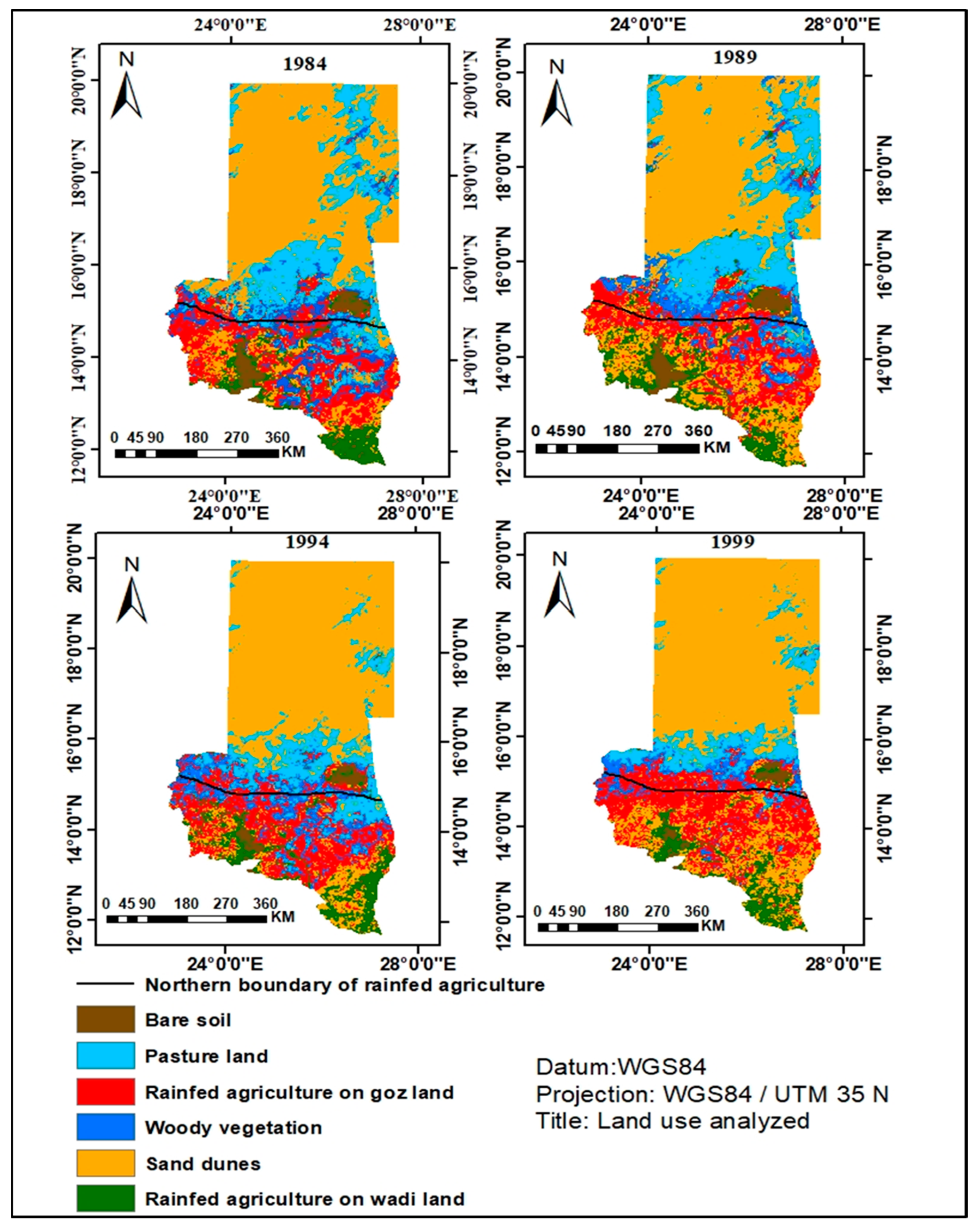


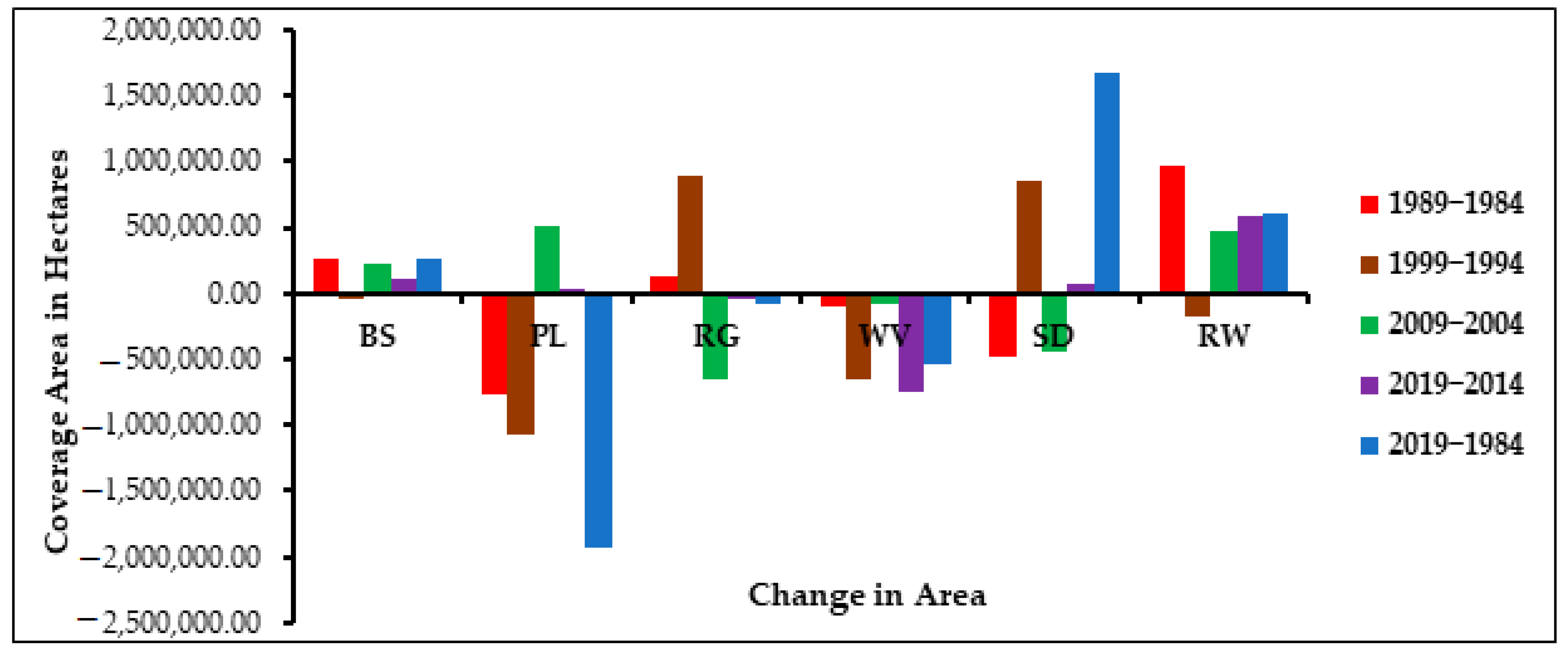

| No. | Class Name | Typical Image of Land Use Class | Description |
|---|---|---|---|
| 1 | Bare soil | 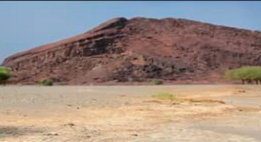 | Wasteland and fallow lands with rocks and gravel. Bare soil is situated in mountainous terrain in the west and some north part of the study area. |
| 2 | Pastureland |  | Vast areas are covered with grassland and shrub used for grazing livestock. |
| 3 | Rainfed agriculture on goz land |  | Goz areas comprise undulating sandy accumulations of old and stabilised dune belts used for farming millet, sorghum and groundnut. |
| 4 | Sand dunes | 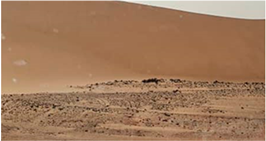 | Areas covered with large masses of shifting sand and un-vegetated old dunes with low levels of organic matter and nitrogen. They occupy most parts of the study area. |
| 5 | Woody vegetation | 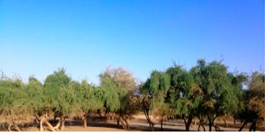 | Areas covered with woody vegetation, mostly Acacia tree species. |
| 6 | Rainfed agriculture on wadi land |  | Wadi areas are generally wetter areas for growing vegetables (on clay soils) and tobacco (on alluvial soils). |
| Class | 1984 Area (ha) | 1989 Area (ha) | 1994 Area (ha) | 1999 Area (ha) | 2004 Area (ha) | 2009 Area (ha) | 2014 Area (ha) | 2019 Area (ha) |
|---|---|---|---|---|---|---|---|---|
| BS | 829,963.35 | 1,092,219.57 | 596,770.74 | 554,768.19 | 1,048,919.04 | 1,268,379.0 | 978,837.93 | 1,096,148.25 |
| PL | 6,087,037.68 | 5,316,714.45 | 4,230,389.88 | 3,165,771.51 | 5,572,342.98 | 6,075,850.59 | 4,135,044.24 | 4,164,688.62 |
| RG | 3,997,107.09 | 4,120,391.79 | 3,919,095.54 | 4,808,718.01 | 4,085,995.14 | 3,427,426.53 | 3,952,211.58 | 3,917,382.48 |
| SD | 15,491,287.71 | 15,001,726.86 | 17,586,085.59 | 18,438,988.41 | 15,579,090.63 | 15,128,433.0 | 17,098,441.11 | 17,161,364.97 |
| WV | 3,255,871.68 | 3,155,611.14 | 2,809,914.39 | 2,155,598.64 | 2,586,354.75 | 2,497,371.93 | 3,478,485.15 | 2,722,680.9 |
| RW | 2,063,802.42 | 3,038,405.4 | 2,582,809.29 | 2,400,107.49 | 2,852,367.39 | 3,327,608.88 | 2,082,289.68 | 2,662,804.71 |
| Years\Accuracy Types | BS | PL | RG | SD | WV | RW |
|---|---|---|---|---|---|---|
| 1984 Producer | 95.7 | 87.9 | 96.2 | 96.6 | 95.7 | 96.0 |
| 1984 User | 93.1 | 90.1 | 95.8 | 95.9 | 95.3 | 97.2 |
| 1989 Producer | 92.7 | 94.5 | 96.9 | 95.8 | 95.4 | 95.9 |
| 1989 User | 91.6 | 96.5 | 96.5 | 95.8 | 96.3 | 94.4 |
| 1994 Producer | 96.4 | 97.6 | 95.8 | 96.1 | 97.4 | 98.3 |
| 1994 User | 97.4 | 96.7 | 96.7 | 96.5 | 93.8 | 98.2 |
| 1999 Producer | 93.8 | 90.5 | 95.1 | 98.1 | 92.4 | 95.8 |
| 1999 User | 92.4 | 93.7 | 95.5 | 96.8 | 95.5 | 94.9 |
| 2004 Producer | 94.7 | 96.1 | 97.2 | 98.1 | 92.1 | 96.2 |
| 2004 User | 97.4 | 95 | 96.3 | 97.8 | 92.3 | 97.4 |
| 2009 Producer | 89.5 | 92.8 | 94.7 | 98.2 | 96.3 | 93.2 |
| 2009 User | 92.3 | 94.8 | 95.4 | 95.6 | 94.1 | 95.8 |
| 2014 Producer | 93.7 | 96.3 | 95.1 | 97.7 | 94.4 | 95.6 |
| 2014 User | 97.2 | 95.9 | 95.8 | 94.9 | 91.7 | 96.9 |
| 2019 Producer | 94.6 | 96.8 | 95.1 | 98.5 | 93.6 | 92.7 |
| 2019 User | 89.7 | 95.2 | 95.9 | 94.9 | 96.4 | 96.2 |
| INITIAL STATE 1984 | ||||||||
|---|---|---|---|---|---|---|---|---|
| BS | PL | RG | SD | WV | RW | Total | ||
| FINAL STATE 1989 | BS | 15,046.80 | 29.81 | 122.23 | 804.90 | 486.23 | 1507.02 | 17,996.98 |
| PL | 72.1 | 208,773.20 | 85,505.09 | 11,589.50 | 13.00 | 15,124.68 | 321,077.57 | |
| RG | 95.43 | 41,758.94 | 159,112.00 | 418.70 | 279.97 | 61,651.45 | 263,316.5 | |
| SD | 1297.30 | 43,977.31 | 32,404.27 | 48,065.40 | 31.28 | 3772.72 | 129,520.1 | |
| WV | 1111.82 | 5.13 | 53.80 | 351.31 | 171.40 | 497.412 | 2190.873 | |
| RW | 979.22 | 2872.98 | 41,783.83 | 1445.50 | 283.03 | 117,497.70 | 164,862.3 | |
| Total | 18,537.77 | 297,417.40 | 318,981.20 | 62,675.31 | 1236.761 | 200,051.00 | 898,899.4 | |
| Image difference | −48.88 | 23,595.31 | −55,664.73 | 68,134.91 | 603.15 | −36,619.76 | ||
| INITIAL STATE 1994 | ||||||||
|---|---|---|---|---|---|---|---|---|
| BS | PL | RG | SD | WV | RW | Total | ||
| FINAL STATE 1999 | BS | 18,385.5 | 118.48 | 570.41 | 9165.10 | 3986.31 | 1060.09 | 33,285.89 |
| PL | 21.22 | 52,827.90 | 16,730.92 | 9785.05 | 352.81 | 3090.45 | 82,808.35 | |
| RG | 158.71 | 3098.00 | 88,305.13 | 663.55 | 4034.80 | 37,301.67 | 161,443.90 | |
| SD | 5591.4 | 2133.99 | 393.12 | 5517.13 | 231.90 | 694.10 | 14,561.64 | |
| WV | 6854.67 | 910.37 | 2147.27 | 632.94 | 30,085.10 | 17,869.56 | 58,499.91 | |
| RW | 1845.35 | 5410.52 | 41,580.27 | 1069.50 | 19,959.00 | 72,346.17 | 142,210.80 | |
| Total | 32,856.85 | 92,381.26 | 149,727.10 | 26,833.27 | 58,649.92 | 132,362.00 | 475,637.67 | |
| Image difference | 429.04 | −9572.91 | 11,716.74 | −12,271.60 | −150.01 | 9848.77 | ||
| INITIAL STATE 2004 | ||||||||
|---|---|---|---|---|---|---|---|---|
| BS | PL | RG | SD | WV | RW | Total | ||
| FINAL STATE 2009 | BS | 17,032.80 | 10.40 | 24.312 | 91,873.10 | 6807.70 | 320.57 | 116,068.9 |
| PL | 13.05 | 141,499.50 | 63,336.03 | 5872.80 | 140.052 | 5328.17 | 216,189.6 | |
| RG | 431.25 | 25,311.30 | 131,389.00 | 2011.46 | 1449.68 | 44,494.65 | 204,699.2 | |
| SD | 192.10 | 42,262.14 | 3720.20 | 41,957.00 | 907.90 | 210.88 | 89,250.2 | |
| WV | 4004.68 | 715.02 | 868.71 | 7561.90 | 31,568.50 | 9117.55 | 53,192.8 | |
| RW | 1489.39 | 1469.56 | 21,091.70 | 1754.07 | 14,348.10 | 72,582.91 | 112,735.7 | |
| Total | 22,775.15 | 210,624.4 | 220,430.0 | 151,030.3 | 55,221.93 | 132,054.7 | 792,136.5 | |
| Image difference | 93,293.73 | 5565.20 | −15,730.7 | −61,780.1 | −2029.08 | −19,319.0 | ||
| INITIAL STATE 2014 | ||||||||
|---|---|---|---|---|---|---|---|---|
| BS | PL | RG | SD | WV | RW | Total | ||
| FINAL STATE 2019 | BS | 22,383.1 | 84.61 | 485.17 | 9172.8 | 3810.49 | 685.50 | 36,621.67 |
| PL | 88.8 | 25,370.4 | 17,985.62 | 7579.45 | 160.18 | 110.1 | 51,294.55 | |
| RG | 99.28 | 17,951.2 | 91,644.91 | 686.31 | 3627.22 | 39,411.50 | 15,3420.4 | |
| SD | 187.14 | 4890.45 | 1222.68 | 14,668.8 | 42.2 | 101.50 | 21,112.77 | |
| WV | 1027.6 | 295.69 | 1625.43 | 2071.4 | 47,767.8 | 11,759.44 | 64,547.36 | |
| RW | 2247.70 | 1779.92 | 16,800.80 | 716.4 | 34,313.0 | 79,704.27 | 135,562.1 | |
| Total | 26,033.62 | 50,372.27 | 129,764.6 | 34,895.16 | 89,720.89 | 131,772.3 | 462,558.9 | |
| Image difference | 10,588.05 | 922.28 | 23,655.81 | −13,782.4 | −25,173.5 | 3789.78 | ||
Disclaimer/Publisher’s Note: The statements, opinions and data contained in all publications are solely those of the individual author(s) and contributor(s) and not of MDPI and/or the editor(s). MDPI and/or the editor(s) disclaim responsibility for any injury to people or property resulting from any ideas, methods, instructions or products referred to in the content. |
© 2023 by the authors. Licensee MDPI, Basel, Switzerland. This article is an open access article distributed under the terms and conditions of the Creative Commons Attribution (CC BY) license (https://creativecommons.org/licenses/by/4.0/).
Share and Cite
Altoom, M.B.; Adam, E.; Ali, K.A. Mapping and Monitoring Spatio-Temporal Patterns of Rainfed Agriculture Lands of North Darfur State, Sudan, Using Earth Observation Data. Land 2023, 12, 307. https://doi.org/10.3390/land12020307
Altoom MB, Adam E, Ali KA. Mapping and Monitoring Spatio-Temporal Patterns of Rainfed Agriculture Lands of North Darfur State, Sudan, Using Earth Observation Data. Land. 2023; 12(2):307. https://doi.org/10.3390/land12020307
Chicago/Turabian StyleAltoom, Mohammed B., Elhadi Adam, and Khalid Adem Ali. 2023. "Mapping and Monitoring Spatio-Temporal Patterns of Rainfed Agriculture Lands of North Darfur State, Sudan, Using Earth Observation Data" Land 12, no. 2: 307. https://doi.org/10.3390/land12020307






